Top 10 Earthworks & Land Art Masters
Land Art, also known as Earth Art or Earthworks, is a contemporary art movement that emerged in the late 1960s and early 1970s primarily in the United States. It involves creating artworks directly in the landscape using natural materials found on-site, such as soil, rocks, vegetation, and water, or by reshaping the land itself. Land Art often blurs the boundaries between art and the environment, aiming to create immersive experiences that interact with the natural world. The essence of Land Art lies in its relationship with nature and the landscape. Artists who practice Land Art seek to engage with the earth in a way that is both respectful and transformative, often highlighting environmental issues or exploring philosophical concepts related to humanity's connection with the natural world. Land Art pieces are typically large-scale and site-specific, designed to complement or alter the surrounding landscape rather than existing as separate entities. Land Art emerged in response to the increasing industrialization and urbanization of society, as artists sought to reconnect with the land and challenge traditional notions of art and exhibition spaces. Influenced by movements such as Minimalism and Conceptual Art, Land Art emphasized the importance of process, materiality, and the relationship between art and its environment. Prominent Land Art practitioners include Robert Smithson, who created the iconic Spiral Jetty in the Great Salt Lake, Utah, in 1970, and Michael Heizer, known for his monumental earthworks such as Double Negative in Nevada. Other notable artists associated with Land Art include Nancy Holt, Walter De Maria, and Christo and Jeanne-Claude.
1. Andy Goldsworthy
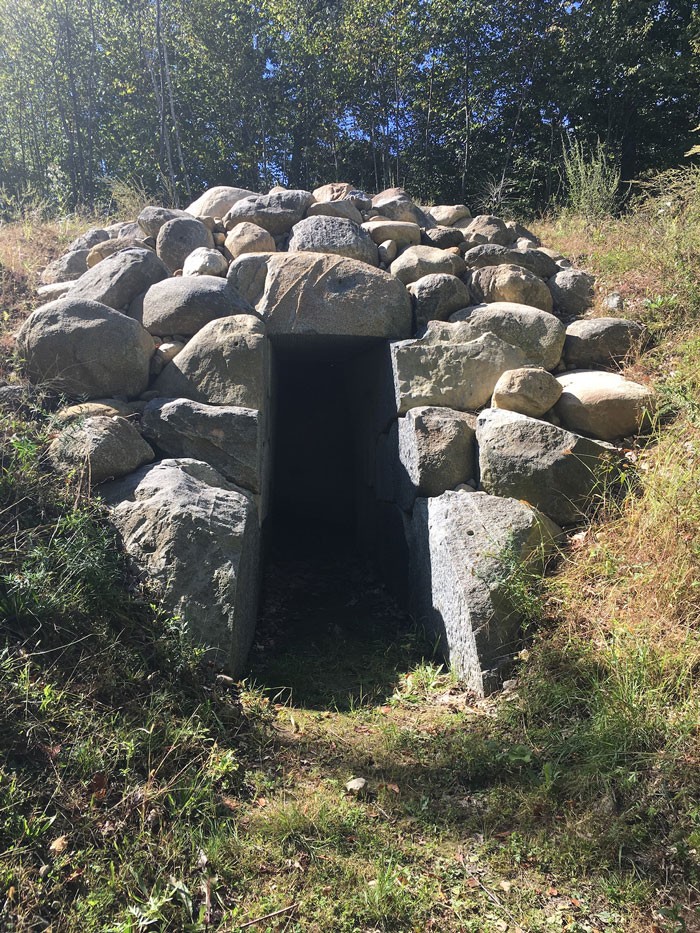
Andy Goldsworthy, Boulder House, 2015- 16.
Andy Goldsworthy is a renowned British artist known for his exceptional contributions to Land Art and Earthworks. His works often involve the use of natural materials found on-site, such as stones, leaves, ice, and branches, to create ephemeral sculptures and installations that interact with the environment. One of the most fascinating aspects of Goldsworthy's art is its transitory nature. This emphasis on impermanence highlights Goldsworthy's philosophical exploration of the cycles of life, death, and regeneration in the natural world. This documentation serves as a crucial aspect of his artistic practice, allowing viewers to experience his works long after they have vanished from the landscape. Throughout his career, Goldsworthy has created a vast and diverse body of work, ranging from delicate leaf arrangements and intricate stone sculptures to monumental installations that span entire landscapes.
In Goldsworthy's "Spire" (2008), towering eucalyptus trunks stand in harmonious balance, a testament to the fusion of human artistry with natural splendor. His "Leaf Works" series transforms fallen leaves into intricate compositions, celebrating the fleeting beauty of nature's ever-changing palette. "Icicle Star" (1987) captures winter's enchanting beauty as icicles are artfully arranged into a radiant star, evoking the mesmerizing allure of icy landscapes. Each work by Goldsworthy encapsulates his reverence for nature's beauty, showcasing his ability to create ephemeral masterpieces that resonate with the timeless allure of the natural world.
2. Robert Smithson

Robert Smithson, Spiral Jetty, 1970
A comprehensive review of land art must acknowledge the foundational influence of Robert Smithson as well. Robert Smithson was a pioneering figure in the Land Art and Earthworks movement of the 1960s and 1970s. One of Smithson's most famous works is "Spiral Jetty" (1970), located in the Great Salt Lake of Utah. This monumental earthwork consists of a 1,500-foot-long coil of rocks and earth that extends into the lake, forming a mesmerizing spiral shape. "Spiral Jetty" is a prime example of Smithson's interest in site-specific interventions that interact with the landscape in dynamic ways. Six days were needed for construction, requiring several heavy construction machines to move 6,650 tons of rock and soil into the lake. Another notable work by Smithson is "Broken Circle/Spiral Hill" (1971), located in the Netherlands. This earthwork features a large circular mound of earth surrounded by a spiraling pathway, creating a striking visual contrast between geometric form and natural terrain. Like many of Smithson's works, "Broken Circle/Spiral Hill" explores themes of entropy, transformation, and the passage of time.
Tragically, Smithson's life was cut short at the age of 35 when he died in a plane crash while surveying potential sites for his artwork. Despite his untimely death, Smithson's legacy continues to resonate in the world of contemporary art, inspiring generations of artists to explore new ways of engaging with the natural world and challenging traditional notions of art and landscape.
3. Walter de Maria
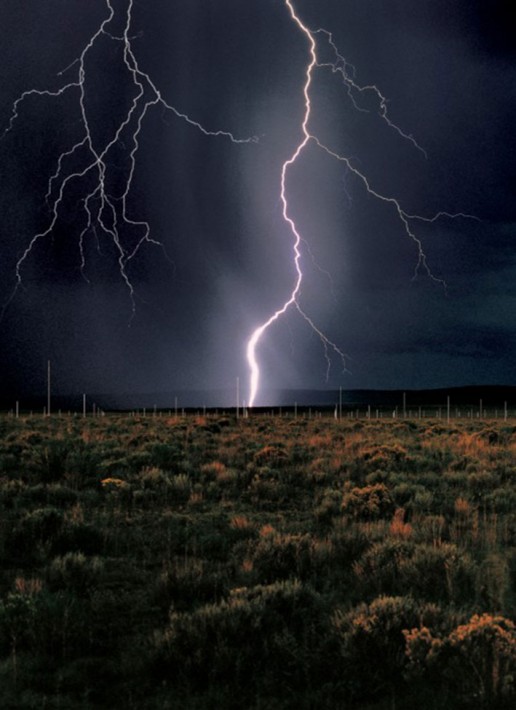
Walter De Maria, Lighting Field, 1977
Walter de Maria, American artist, an influential figure in the Land Art and Earthworks movement, reshaped the landscape with his monumental installations that engaged with the natural world in profound ways. One of de Maria's most famous works is "The Lightning Field" (1977), located in western New Mexico. This expansive installation consists of 400 stainless steel poles arranged in a grid over an area of one mile by one kilometer. The poles, which stand 20 feet tall, attract lightning during thunderstorms, creating a mesmerizing spectacle of light and sound that transforms the surrounding landscape. Another notable work by de Maria is "The New York Earth Room" (1977), located in New York City. This indoor earthwork occupies an entire floor of a building in downtown Manhattan and consists of 250 cubic yards of soil spread across the space. Visitors are invited to walk through the room and experience the earth's texture and scent, blurring the boundaries between interior and exterior, nature and culture.
In 2013, Walter de Maria sadly passed away, yet his legacy endures through his groundbreaking artworks, which continue to challenge artistic norms and deepen our connection with the natural world. His contributions have left an indelible mark on the Land Art movement, inspiring future generations of artists to explore new ways of engaging with the environment.
4. Nancy Holt
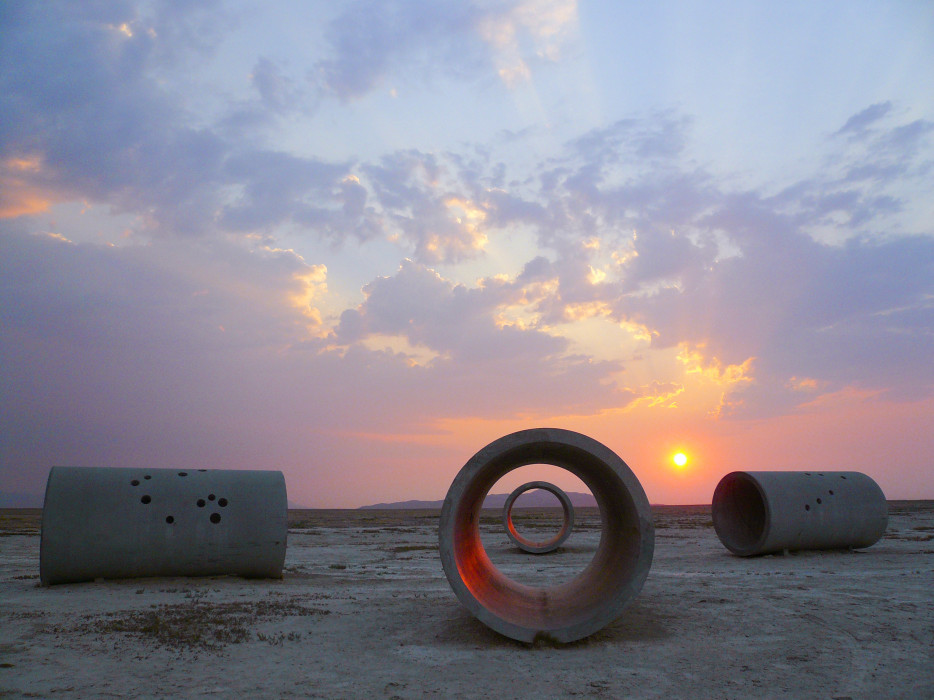
Nancy Holt, Sun Tunnels, 1973–76
One of the outstanding figures of the Land movement is Nancy Holt, whose works are equally impressive and significant. Famous for her mastery in public sculpture, installation art, and land art, Nancy Holt established herself as a pioneering American artist whose work continues to inspire audiences worldwide. She redefined the bounds of artistic expression and expanded the possibilities of where art may be encountered by revolutionizing the idea of site-specific installation and embracing the growing medium of moving images. Holt's most iconic work is "Sun Tunnels," completed in 1976 in the remote Utah desert. This monumental earthwork consists of four large concrete tubes arranged in an open X configuration, each precisely aligned with the sunrise and sunset during the solstices. "Sun Tunnels" offer viewers a meditative experience as they interact with the ever-changing light and shadow cast by the tubes throughout the day. Another notable work by Holt is "Dark Star Park," located in Arlington, Virginia. Created in 1984, this public art installation features five large spheres and a series of poles positioned to align with the shadows they cast on specific dates each year. "Dark Star Park" serves as a dynamic monument to the passage of time and the interplay between natural and man-made structures. Throughout her career, Holt also collaborated with her husband, artist Robert Smithson, on various projects. One such collaboration was "Primary Structures (1966)," a series of sculptures that explored the relationship between geometric forms and the surrounding landscape.
Nancy Holt passed away in 2014, at the age of 75. Following her death, many praised her innovative contributions to the art world and her groundbreaking work in land art and public sculpture. She was remembered for her visionary approach to art-making, her commitment to exploring the relationship between art and the natural environment, and her lasting impact on contemporary art practice.
5. Michael Heizer
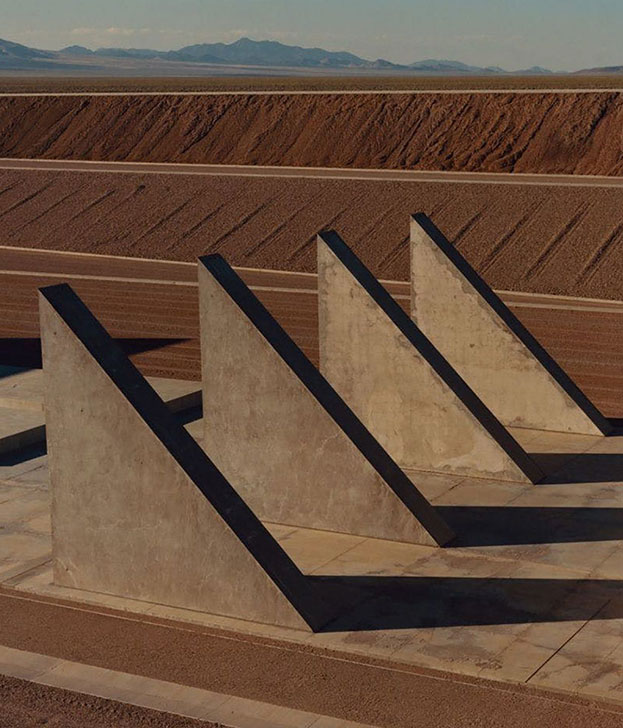
Michael Heizer, City, 1972 - 2020
Michael Heizer is an American artist celebrated for his monumental Land Art and Earthworks, which have left an indelible mark on the landscape of contemporary art. From his twenties in the late 1960s, Michael Heizer has been a leading player in the land art movement. He is well recognized for his ability to construct large-scale works and investigate the interplay between positive and negative space. "Double Negative," created in 1969-1970, is perhaps Heizer's most famous work and a seminal piece of Land Art. Located in the desolate landscape of the Nevada desert near Overton, "Double Negative" consists of two massive trenches carved into the earth, each measuring 30 feet wide, 50 feet deep, and 1,500 feet long. The trenches form a negative space, cutting through the natural terrain and altering the viewer's perception of the landscape. "City," on the other hand, is an ongoing project that Heizer began in 1972 in the remote desert of Nevada. Often referred to as one of the largest sculptures in the world, "City" is a monumental and ambitious endeavor that seeks to create an entire cityscape out of earth, rock, and concrete. Heizer's vision for "City" is to construct a vast network of geometric forms, architectural structures, and open spaces spread across the desert landscape. The project encompasses various elements, including massive earthen mounds, carved cliffs, and geometric shapes reminiscent of ancient civilizations. What sets "City" apart is its sheer scale and ambition, with Heizer envisioning it as a permanent and evolving artwork that spans over 1.25 miles in length and covers an area of over 1 square mile.
Michael Heizer's City, one of the largest sculptures ever created, is almost the same size as the National Mall and was inspired by ancient monuments, minimalism, industrial technology, and other works he observed while visiting Chichen Itza.
6. Ana Mendieta
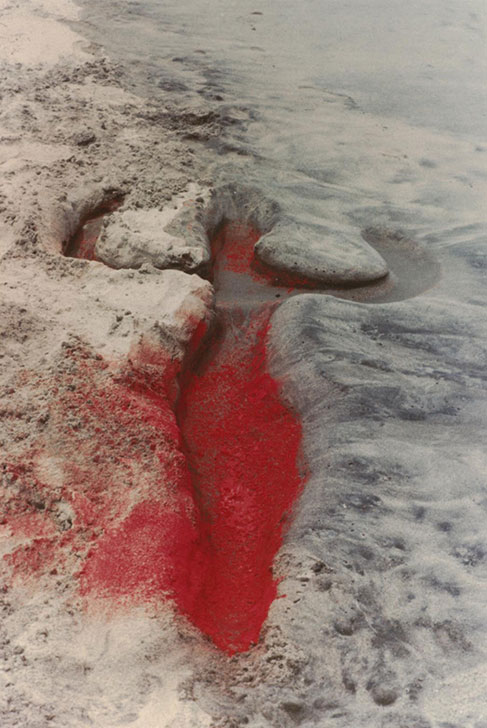
Ana Mendieta, Silueta, 1973 - 76.
Ana Mendieta, a pioneering Cuban feminist artist, is celebrated for her groundbreaking contributions to Land Art, particularly for her exploration of the relationship between the human body and the natural world. Mendieta became well-known for her nature-based artwork, which she referred to as "earth-body" art, and her performative actions. With a prolific portfolio comprising over 200 works, Mendieta used her own body and the earth itself as mediums to create provocative and thought-provoking sculptures. Her artistic practice was deeply philosophical, intertwining elements of performance art, body art, conceptualism, and land art to address themes of human equality, the cyclical nature of life and death, and the profound force of mother nature. Among her most renowned projects is the "Silueta" series (1973-1980), where she ventured into various landscapes across Iowa and Mexico to mold her body into the earth, showcasing the inseparable connection between human existence and the natural world. Mendieta made body prints or painted her outline or silhouette onto a wall, using natural materials like leaves, twigs, and blood, to create feminine silhouettes in the mud, sand, and grass.
Through her art, Mendieta sought to address fragmented identities, particularly those of oppressed female artists and refugees, while also raising questions about ecology and the body. Her works serve as a powerful testament to the enduring strength and resilience of the human spirit, as well as a poignant reminder of our interconnectedness with the earth.
7. Agnes Denes

Agnes Denes, Wheatfield-a Confrontation, 1982
Agnes Denes is a Hungarian-American artist known for her pioneering work in the fields of environmental art, land art, and conceptual art. Born in Budapest in 1931, Denes immigrated to the United States with her family in 1949, eventually settling in New York City. Denes' work is characterized by its intersection of art, science, and philosophy, often exploring themes related to ecology and environmental sustainability. She gained prominence in the 1960s and 1970s for her conceptual projects and installations that challenged traditional notions of art and its role in society. One of Denes' most famous works is "Wheatfield – A Confrontation" (1982), in which she planted a two-acre wheatfield in the Battery Park landfill in Manhattan, one of the most densely populated areas of New York City. The project aimed to raise awareness about urban development, land use, and environmental stewardship. Denes meticulously cultivated the wheatfield, which stood as a striking contrast to the surrounding concrete jungle, serving as a powerful symbol of nature's resilience and the potential for transformation in urban landscapes. Another notable work by Denes is "Tree Mountain – A Living Time Capsule" (1992-1996), located near Ylöjärvi, Finland. This ambitious project involved planting 11,000 trees on a man-made mountain, which was created from the excavation of gravel pits. Denes conceived the project as both an ecological restoration effort and a long-term art installation, with the intention that the trees would grow and evolve over centuries, serving as a living testament to the passage of time and humanity's relationship with the natural world. Denes' work is particularly intriguing due to its interdisciplinary nature, combining elements of art, science, and environmental activism. Through her innovative and thought-provoking works, Denes continues to inspire dialogue and reflection on pressing environmental issues and the role of art in addressing them.
8. Richard Long
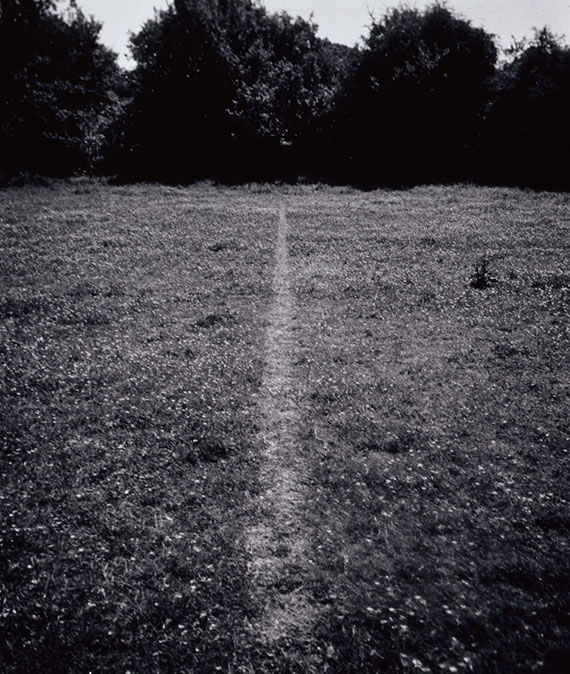
Richard Long, A Line Made By Walking, 1967
Richard Long is a British artist known for his significant contributions to the Land Art movement. Born in Bristol, England, in 1945, Long studied at the West of England College of Art before embarking on his artistic career. Long's work is characterized by his use of natural materials and landscapes as both medium and subject matter. Beginning in 1969, Long embarked on an exploration of his walking practice in wilderness areas worldwide, which included an undertaking in the Alps. As he worked on his enormous land sculpting projects in the 1980s, Long began incorporating natural materials into indoor environments. He used his handprints affixed to the wall to create mud paintings or sculptures made of organic materials. He gained prominence in the late 1960s and early 1970s for his innovative approach to creating art in the environment, often through processes of walking, collecting, and arranging materials found in nature. One of Long's most famous works is "A Line Made by Walking" (1967), in which he walked back and forth across a field until a distinct line was created in the grass. This simple yet profound act of marking the landscape with his body became a seminal piece in the Land Art movement, challenging traditional notions of art-making and the relationship between artist and environment. Another notable work by Long is "Walking a Straight Line in Peru" (1972), in which he walked along the perimeter of a large, rectangular field in Peru, creating a temporary geometric form that echoed the lines and shapes found in the surrounding landscape. This work highlights Long's interest in geometry, mathematics, and the interplay between human intervention and natural forms. Long's work is interesting for its minimalist aesthetic and conceptual underpinnings, as well as its engagement with ideas of time, space, and the experience of walking.
9. Christo and Jeanne-Claude
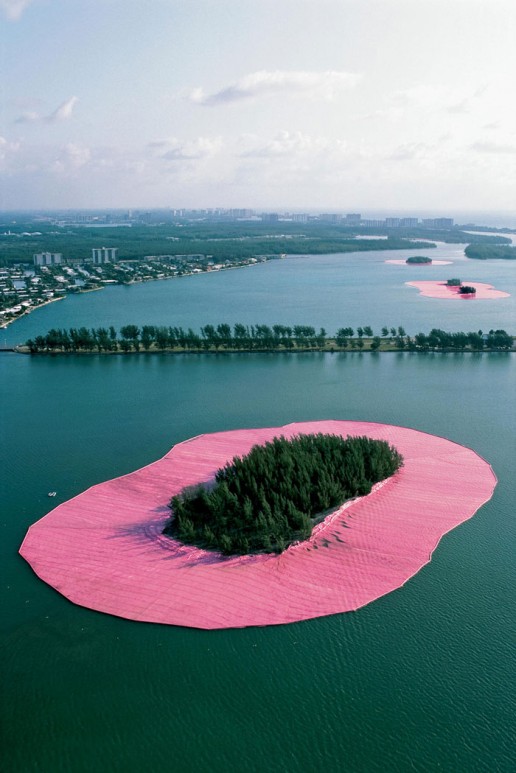
Christo And Jeanne- Claude, Surrounded Islands, 1980 - 83
Christo and Jeanne-Claude were a dynamic artistic duo known for their monumental environmental artworks that transformed landscapes and captivated audiences worldwide. Their collaborative projects often involved wrapping large-scale objects or entire buildings in fabric, creating temporary installations that challenged perceptions of space, scale, and beauty. Renowned for their ambitious vision and meticulous attention to detail, Christo and Jeanne-Claude's works blurred the boundaries between art, architecture, and the natural world, leaving a lasting impact on contemporary art history. One of their most iconic projects was "The Gates" in New York City's Central Park, where they installed thousands of saffron-colored fabric panels along pathways, creating a stunning visual spectacle that drew millions of visitors. Some of their most well-known monumental projects are the 5.5 meters high and 39.4 kilometers long Running Fence (1972–76), the Surrounded Islands (1980–83), the Valley Curtain (1970–72), the 400 meters long cloth stretched across Rifle Gap, and the wrapping of a million square feet of coastline next to Sydney, known as Wrapped Cost (1968–69). In this piece, eleven islands in Miami's Biscayne Bay were encircled with 603,870 square meters of floating pink propylene cloth. One of the latest developments in Central Park, New York, is The Gates (2005). Christo carried on with the couple's projects after Jeanne-Claude passed away in 2009; these included Big Air Package (2013), The Floating Piers (2016), and The London Mastaba (2018).
10. Milton Becerra
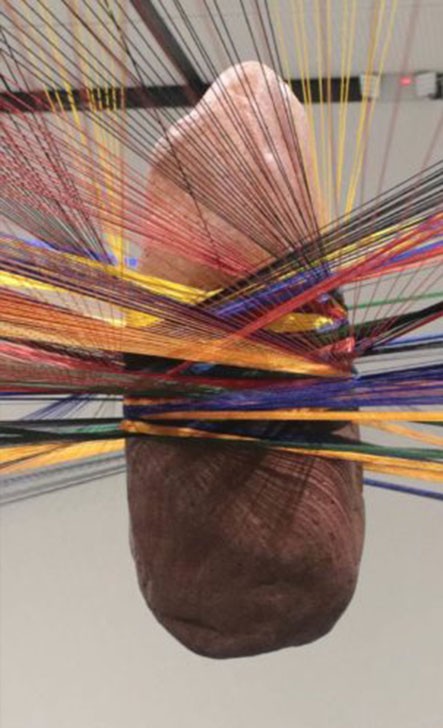
Milton Becerra, Sinfonía Del Universo, 2018.
The Venezuelan artist Milton Becerra rose to prominence as the pioneer in the Earthworks and Land Art movements. His works have a strong link to the natural world and traditional culture. He worked as an assistant in the workshops of Carlos Cruz-Diez and Jesús Soto, two well-known masters, from 1973 until 1980. While he was still a student, he studied styles including Concrete, Neo, Kinetic, Generative, and Op-art and took part in his first group exhibition. He held his first solo exhibition in 1973.
One of Becerra's notable works is "The Tower of the Sun," a monumental sculpture located in the Venezuelan Amazon rainforest. This towering structure, crafted from local wood and vines, rises majestically above the dense canopy. Another striking creation is "Sacred Earth," an expansive land art installation that spans acres of desert terrain in the southwestern United States. Here, Becerra meticulously arranges stones and earth to form intricate patterns and symbols, honoring the ancient traditions of indigenous cultures. In addition to his profound artistic endeavors, Milton Becerra's legacy is further enriched by his dedication to environmental activism and cultural preservation. His works serve as poignant reminders of the fragility and beauty of the natural world, inspiring viewers to reflect on their role as stewards of the earth.
Becerra moved to Paris in the 1980s and undertook a life-changing adventure inspired by his in-depth studies and observations of the rituals of the Yanomami tribe of the Amazon. His unique style began to take shape during this time, which is distinguished by the way he weaves yarns, cloth, and light with natural objects like rocks. At this period, he created critically acclaimed television shows, including Chin-cho-rro (1995), Gotas (Drops 1990), and Nidos (Nests 1995). As for his current status, Milton Becerra's contributions to the art world continue to resonate.
No Comments Yet...